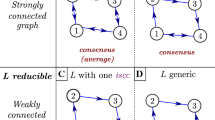We propose a mathematical model for the diffusion of opinions, which eventually leads to the attainment of the state of consensus. The theory of conflict dynamical systems with attractive interaction is used for the construction of a model. The behavior of the model in the case of making binary decisions is described in detail and the behavior of trajectories in the decision-making model with many alternative positions is investigated.
Similar content being viewed by others
References
M. de Groot, “Reaching a consensus,” J. Amer. Statist. Assoc., 69, 118–121 (1974).
R. Hegselmann and U. Krause, “Opinion dynamics and bounded confidence models, analysis and simulations,” J. Artificial Soc. Soc. Simul., 5, No. 3 2002).
G. Deffuant, D. Neau, F. Amblard, and G.Weisbuch, “Mixing beliefs among interacting agents,” Adv. Complex Syst., 3, 87–98 (2000).
G. Weisbuch, “Bounded confidence and social networks,” Europ. Phys. J. B, 38, No. 2, 339–343 (2004).
L. Li, A. Scaglione, A. Swami, and Q. Zhao, “Consensus, polarization, and clustering of opinions in social networks,” IEEE J. Select. Areas Comm., 31, No. 6, 1072–1083 (2013).
L. Li, A. Scaglione, A. Swami, and Q. Zhao, “Trust, opinion diffusion, and radicalization in social networks,” in: Proc. of the Asilomar Conference on Signals, Systems, and Computers (2011), pp. 691–695.
H. Hu, “Competing opinion diffusion on social networks,” Roy. Soc. Open Sci., 4, 171160 (2017).
M. E. Yildiz, et al., “Voting models in random networks,” in: Information Theory and Applications Workshop (ITA) (2010), pp. 1–7.
C. Castellano, S. Fortunato, and V. Loreto, “Statistical physics of social dynamics,” Rev. Modern Phys., 81, 591–646 (2009).
D. Watts and S. Strogatz, “Collective dynamics of ’small world’ networks,” Nature, 393, 440–442 (1998).
S. Albeverio, M. V. Bodnarchuk, and V. D. Koshmanenko, “Dynamics of discrete conflict interactions between nonannihilating opponents,” Methods Funct. Anal. Topol., 11, No. 4, 309–319 (2005).
M. V. Bondarchuk, V. D. Koshmanenko, and N. V. Kharchenko, “Properties of the limit states of a dynamical conflict system,” Nelin. Kolyv., 7, No. 4, 446–461 (2004); English translation: Nonlin. Oscillat., 7, No. 4, 432–447 (2004).
S. Albeverio, V. Koshmanenko, and I. Samoilenko, “The conflict interaction between two complex systems: Cyclic migration,” J. Interdiscip. Math., 11, No. 2, 163–185 (2008).
V. D. Koshmanenko and I. V. Samoilenko, “Model of a dynamical system of a conflict triad,” Nelin. Kolyv., 14, No. 1, 55–75 (2011); English translation: Nonlin. Oscillat., 14, No. 1, 56–76 (2011).
V. D. Koshmanenko, “Existence theorems of the 𝜔-limit states for conflict dynamical systems,” Methods Funct. Anal. Topol., 20, No. 4, 379–390 (2014).
V. Koshmanenko, T. Karataieva, N. Kharchenko, and I. Verygina, “Models of the conflict redistribution of vital resources,” in: Social Simulation Conf. (Rome, September 19–23, 2016), p. 4.
V. D. Koshmanenko and T. V. Karataieva, “On personal strategies in conflict socium,” in: Econophys. Colloq. (Warsaw, July 5–7, 2017), p. 32.
V. D. Koshmanenko, Spectral Theory of Dynamical Conflict Systems [in Ukrainian], Naukova Dumka, Kyiv (2016).
T. Karataieva, V. Koshmanenko, M. Krawczyk, and K. Kulakowski, “Mean field model of a game for power,” Physica A, 525, 535–547 (2019).
T. V. Karataeva and V. D. Koshmanenko, “Socium and the mathematical model of a dynamical conflict system,” Nelin. Kolyv., 22, No. 1, 66–85 (2019).
V. Koshmanenko and N. Kharchenko, “Fixed points of complex systems with attractive interaction,” Methods Funct. Anal. Topol., 23, No. 2, 164–176 (2017).
Author information
Authors and Affiliations
Corresponding author
Additional information
Translated from Ukrains’kyi Matematychnyi Zhurnal, Vol. 71, No. 9, pp. 1271–1283, September, 2019.
Rights and permissions
About this article
Cite this article
Satur, O.R., Kharchenko, N.V. A Model of Dynamical System for the Attainment of Consensus. Ukr Math J 71, 1456–1469 (2020). https://doi.org/10.1007/s11253-020-01725-w
Received:
Published:
Issue Date:
DOI: https://doi.org/10.1007/s11253-020-01725-w




